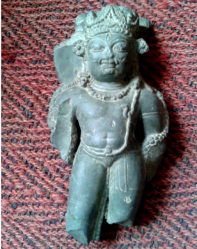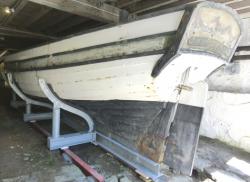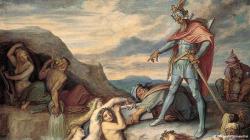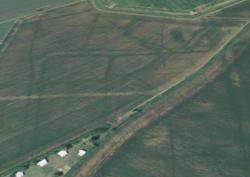INSTITUT SUPERIEUR D'ANTHROPOLOGIE
INSTITUTE OF ANTHROPOLOGY
ONLINE COURSES / COURS A DISTANCE
SPRING TERM : APRIL 2014
REGISTER NOW
INDE –  Wachi - The department of Archives, Archaeology and Museums Kashmir has found a rare stone sculpture of lord Shiva at Wachi Shopian. The sculpture had earlier got unearthed from the river bed of Nallah Rambara at Malhora during an event of Sand extraction of the site. The find was then collected by the concerned DPO Wachi, who informed the Archaeology department. The experts from the department of archaeology inspected the site and collected the artefact. The departmental experts investigating the find have described find a big achievement in field of Kashmir sculpture history. The sculpture has been identified as Lord Shiva, shown wearing three peaked crown. The sculpture has broken arms and legs depicting Shiva with a third eye on its forehead.. The sculpture has been dated to the 9th century AD and has close resemblance with the Vishnu sculptures found earlier from Avantipur. It is in place to mention here that a well advanced sculpture art school flourished at Avantipora during the reign of Raja Avantivarman in the early 9th century AD, but this school mostly produced the sculptures of Vishnu school of thought and Vikunta Vishnu turned to be the most impressive sculpture of this era. There are several such sculptures of Vikunta Vishnu preserved in the State Museum at Lalmandi which are recorded here to have been found from Avantipura. However, there has been no such sculpture evidence from Wachi area of south Kashmir in the archaeological records of the state. The locals claim that there has been no archaeological survey of this area, they have demanding for conducting of the archaeological survey of this area to explore the hidden treasures of Wachi. Although there has been no earlier evidence of any antiquity to have been found in this area but the village is famous for the ancient Khanqah which is believed to have been founded here by Syed Mir Mohammad Hamadani in the 15th century AD.
Wachi - The department of Archives, Archaeology and Museums Kashmir has found a rare stone sculpture of lord Shiva at Wachi Shopian. The sculpture had earlier got unearthed from the river bed of Nallah Rambara at Malhora during an event of Sand extraction of the site. The find was then collected by the concerned DPO Wachi, who informed the Archaeology department. The experts from the department of archaeology inspected the site and collected the artefact. The departmental experts investigating the find have described find a big achievement in field of Kashmir sculpture history. The sculpture has been identified as Lord Shiva, shown wearing three peaked crown. The sculpture has broken arms and legs depicting Shiva with a third eye on its forehead.. The sculpture has been dated to the 9th century AD and has close resemblance with the Vishnu sculptures found earlier from Avantipur. It is in place to mention here that a well advanced sculpture art school flourished at Avantipora during the reign of Raja Avantivarman in the early 9th century AD, but this school mostly produced the sculptures of Vishnu school of thought and Vikunta Vishnu turned to be the most impressive sculpture of this era. There are several such sculptures of Vikunta Vishnu preserved in the State Museum at Lalmandi which are recorded here to have been found from Avantipura. However, there has been no such sculpture evidence from Wachi area of south Kashmir in the archaeological records of the state. The locals claim that there has been no archaeological survey of this area, they have demanding for conducting of the archaeological survey of this area to explore the hidden treasures of Wachi. Although there has been no earlier evidence of any antiquity to have been found in this area but the village is famous for the ancient Khanqah which is believed to have been founded here by Syed Mir Mohammad Hamadani in the 15th century AD.
http://groundreport.com/a-rare-stone-sculpture-of-shiva-found-at-wachi-in-south-kashmir/
ROYAUME UNI -  Castletown- Archaeologists will today start work at the Nautical Museum in Castletown, home of the world’s oldest yacht, the 200-year old Peggy. Specialist archaeological contractors, Oxford Archaeology North, have been commissioned by Manx National Heritage to undertake the project. In preparation for the excavation, Manx National Heritage has worked with local building contractors to complete some minor structural alterations to the building. Chris Weeks, Conservator for Manx National Heritage said: “In recent years, Manx National Heritage has been studying Peggy and the environment in which she sits. The next phase of this project is to carefully excavate the boatyard at the Nautical Museum, where we are expecting to find a slipway leading from the building to Castletown Harbour.” Starting today, the work is expected to take approximately six weeks to complete. Following the excavation, Oxford Archaeology North will produce a report on their discoveries for Manx National Heritage in summer 2014.
Castletown- Archaeologists will today start work at the Nautical Museum in Castletown, home of the world’s oldest yacht, the 200-year old Peggy. Specialist archaeological contractors, Oxford Archaeology North, have been commissioned by Manx National Heritage to undertake the project. In preparation for the excavation, Manx National Heritage has worked with local building contractors to complete some minor structural alterations to the building. Chris Weeks, Conservator for Manx National Heritage said: “In recent years, Manx National Heritage has been studying Peggy and the environment in which she sits. The next phase of this project is to carefully excavate the boatyard at the Nautical Museum, where we are expecting to find a slipway leading from the building to Castletown Harbour.” Starting today, the work is expected to take approximately six weeks to complete. Following the excavation, Oxford Archaeology North will produce a report on their discoveries for Manx National Heritage in summer 2014.
http://www.isleofman.com/News/details/61711/archaeologists-start-work-at-the-nautical-museum
ALLEMAGNE -  Ruelzheim - A hobby archaeologist with a metal detector has discovered a trove of gold and silver in a German forest dating back to late Roman times, fuelling speculation it could be the that inspired Richard Wagner's opera cycle. The haul from the western state of Rhineland Palatinate, worth about 1 million euros, includes silver bowls, brooches and other jewelry from ceremonial robes and small statues that adorned a grand chair, said archaeologists. "In terms of timing and geography, the find fits in with the epoch of the Nibelung legend," Axel von Berg, the state's chief archaeologist was quoted by German media as saying. "But we cannot say whether it actually belongs to the Nibelung treasure," he said, adding that whoever owned it had "lived well" and could have been a prince. The haul, which was found near Ruelzheim in the southern part of the state, is now at the state cultural department in Mainz, but officials suspect they may not have all of it.Whether the treasure is the famous "Rhinegold" or not, it seems to have been buried in haste by its owner or by robbers in around 406-407 BC, when the Roman Empire was crumbling in the area along the Rhine, von Berg said in a statement. According to Nibelung legend, the warrior Hagen killed the dragon-slayer Siegfried and sank his treasure in the Rhine river. The Rhine has shifted its course many times over the centuries, so the treasure need no longer be under water. Although it is the stuff of myths, the story is based on the downfall of the Burgundians in the 5th century.
Ruelzheim - A hobby archaeologist with a metal detector has discovered a trove of gold and silver in a German forest dating back to late Roman times, fuelling speculation it could be the that inspired Richard Wagner's opera cycle. The haul from the western state of Rhineland Palatinate, worth about 1 million euros, includes silver bowls, brooches and other jewelry from ceremonial robes and small statues that adorned a grand chair, said archaeologists. "In terms of timing and geography, the find fits in with the epoch of the Nibelung legend," Axel von Berg, the state's chief archaeologist was quoted by German media as saying. "But we cannot say whether it actually belongs to the Nibelung treasure," he said, adding that whoever owned it had "lived well" and could have been a prince. The haul, which was found near Ruelzheim in the southern part of the state, is now at the state cultural department in Mainz, but officials suspect they may not have all of it.Whether the treasure is the famous "Rhinegold" or not, it seems to have been buried in haste by its owner or by robbers in around 406-407 BC, when the Roman Empire was crumbling in the area along the Rhine, von Berg said in a statement. According to Nibelung legend, the warrior Hagen killed the dragon-slayer Siegfried and sank his treasure in the Rhine river. The Rhine has shifted its course many times over the centuries, so the treasure need no longer be under water. Although it is the stuff of myths, the story is based on the downfall of the Burgundians in the 5th century.
http://www.reuters.com/article/2014/02/19/us-germany-treasure-idUSBREA1I17X20140219?rpc=401&feedType=RSS&feedName=lifestyleMolt&rpc=401
ROYAUME UNI -  Upwell - A former March man believes he could have discovered the remains of a Roman fort in Fenland and is hoping his find could lead to a major archaeological excavation. Greg Owen, a former Neale-Wade School pupil, now lives in Norway and works for a firm with links to mapping and it was while at work he was examining aerial images of his former homeland when he spotted signs of a Roman fort in the Upwell area. “I could see there was a double ditch, which is a clear indication that the area was once occupied by a Roman fort. I started looking at images of sites where forts had already been discovered and it only heightened my suspicions,” explained Greg. He was so convinced by what he was seeing that he arranged to carry out a field walk with the local farmer to see what he could unearth. As a result Greg picked up decorated (Samian) pottery, window glass and other remnants of pottery and roof tiles.The finds only added to Greg’s conviction and he contacted Eberhard Sauer, professor at Edinburgh University, as well as the local archaeology group Fenarch and both Cambridgeshire and Norfolk county archaeology teams. The professor agreed with Greg that the double ditches, with the rounded corners, pointed to the site being home to an undiscovered Roman fort. Other findings also indicated a settlement had grown up around the fort and Greg is convinced the site could be the city of Duroliponte, which is listed in the Antonine Itinerary - a register of stations and distances along various routes and roads of the Roman empire and also containing directions on how to get from one to another. Duroliponte is currently assigned to Cambridge, although no evidence of a Roman fort has ever been uncovered in the city, which is why Greg believes it is actually on his site at Upwell
Upwell - A former March man believes he could have discovered the remains of a Roman fort in Fenland and is hoping his find could lead to a major archaeological excavation. Greg Owen, a former Neale-Wade School pupil, now lives in Norway and works for a firm with links to mapping and it was while at work he was examining aerial images of his former homeland when he spotted signs of a Roman fort in the Upwell area. “I could see there was a double ditch, which is a clear indication that the area was once occupied by a Roman fort. I started looking at images of sites where forts had already been discovered and it only heightened my suspicions,” explained Greg. He was so convinced by what he was seeing that he arranged to carry out a field walk with the local farmer to see what he could unearth. As a result Greg picked up decorated (Samian) pottery, window glass and other remnants of pottery and roof tiles.The finds only added to Greg’s conviction and he contacted Eberhard Sauer, professor at Edinburgh University, as well as the local archaeology group Fenarch and both Cambridgeshire and Norfolk county archaeology teams. The professor agreed with Greg that the double ditches, with the rounded corners, pointed to the site being home to an undiscovered Roman fort. Other findings also indicated a settlement had grown up around the fort and Greg is convinced the site could be the city of Duroliponte, which is listed in the Antonine Itinerary - a register of stations and distances along various routes and roads of the Roman empire and also containing directions on how to get from one to another. Duroliponte is currently assigned to Cambridge, although no evidence of a Roman fort has ever been uncovered in the city, which is why Greg believes it is actually on his site at Upwell
http://www.fenlandcitizen.co.uk/news/latest-news/is-upwell-site-of-a-roman-fort-1-5887176